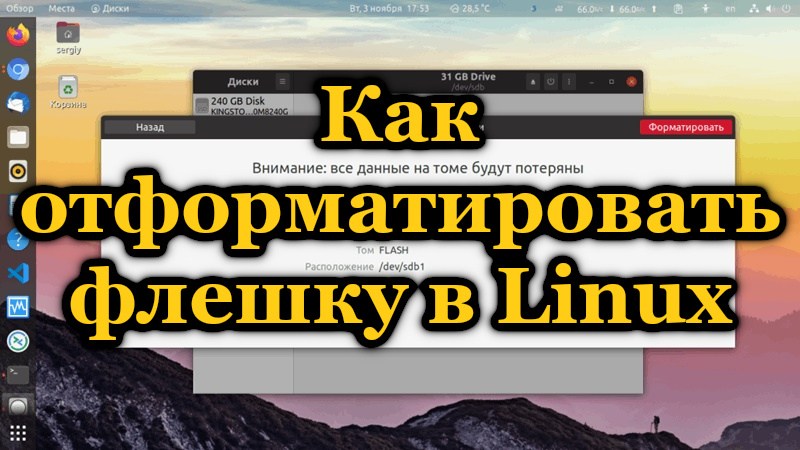The vast majority of users use the Windows operating system on their computers. However, do not forget about other operating systems that can be a great alternative to Windows. One such operating system is, of course, Linux. Free OS with many features and benefits. Of course, in many respects it differs from the usual Windows and many points will have to learn again. Formatting USB drives is something that inexperienced Linux users are not familiar with. In this article, we will take a closer look at how to format a USB flash drive in Linux. Let’s figure it out. Go!

This can be done in several ways. All of them equally solve the problem, so you just have to choose the most suitable one for you.
The first option is to manually format the USB drive. To do this, go to the command line mode (Ctrl + Alt + T) and write the command:
# dmesg | tail
This will help you find out the name of the flash drive. It will be indicated in square brackets. The next step is to unmount it if it has already been mounted. This is an extremely important condition, without which nothing will work. Therefore, in the terminal enter the command:
$ sudo umount /dev/название_носителя
Next, if you want to format with the FAT32 file system, enter the command:
$ sudo mkfs.vfat /dev/название_носителя
Or for formatting in the NTFS file system:
$ sudo mkfs.ntfs /dev/название_носителя
If you have Ubuntu installed, you can use a built-in utility called Palimpsest. Using it is extremely simple. First launch Palimpsest, then select the USB flash drive, specify the required file system, enter the name and click on the “Format” button. Very simple and fast. If suddenly this utility is missing on your computer, write the command to install it:
sudo apt-get install palimpsest
Formatting a USB stick in Gparted
For this method, you need the Gparted utility. The official repositories make it quite easy to install this graphical tool using a special command in Ubuntu:
$ sudo apt-get install gparted
You can find and open the newly installed program directly through the Dash panel or by using the query:
$ gparted-pkexec
After a successful launch, adhere to the following sequence of actions:
- The first step is to find your USB stick in the drop-down list located in the upper right corner.
- Unmount the removable drive by right-clicking on the appropriate section and selecting “Unmount”. If there are several partitions, you will have to unmount each of them.
- After the performed operations, click on any of the sections (if it is not one) and select “Format to” in the context menu and the file system that you want to use.
- To apply the changes made, click on the green checkmark icon at the top of the working panel, or do the same via Edit → Apply.
- Upon confirmation of formatting, the process will automatically start.
Graphical interface
Another available option for formatting a Flash drive is to use the graphical environment of the distribution kit. For error-free execution of all operations, we recommend that you familiarize yourself with the main stages and their features.
- Open the file manager and then right-click on the name of the flash drive and select the “Format” option.
- In the next dialog box, enter the name of the volume and make the rest of the settings, if necessary. You can independently set the file system format and additionally erase all data stored on the disk. Having defined the attributes, click on the “Next” button.
- The last step is to double-check all the information and confirm the details by clicking on “Format”.
How to format a USB flash drive using Disk
Disk Utillity is a standard disk management program for Linux distributions with a Gnome environment, usually installed on the system by default. We present to your attention detailed instructions for its use.
- Run the utility from the main Dash menu, after typing the word “disk” in the search bar.
- From all the available devices that are displayed on the left side of the window that opens, find the USB flash drive. Be guided by the parameters shown on the right, in particular, the size and mark of the disc.
- Unplug the USB drive using the “Unmount Volume” item.
- To start the formatting process, on the right side of the application, click on “Format Volume”.
- Select a file system format and enter a name for your drive.
- Confirm the action by clicking the “Format” button.
As you can see, this task can be solved very simply and quickly. Even an inexperienced user can easily cope with this.
Now you know how to format a USB flash drive in Linux. Write in the comments if you managed to solve the problem, share your own experience with other users and ask everything that interests you on the topic of this article.